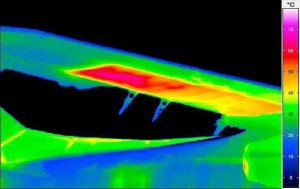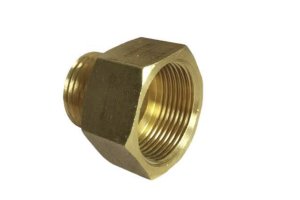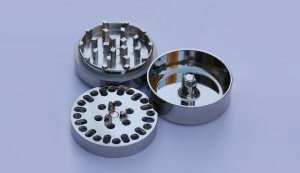Introduction: The Backbone of a Vehicle’s Steering System
When I first entered the manufacturing world, I was fascinated by the complexity of even the most straightforward vehicle components. One such component that always caught my attention was the steering shaft—a critical part of the steering system that allows the driver to control the vehicle. What seems like a simple part actually plays a crucial role in vehicle performance and safety.
As someone who has worked hands-on in CNC machining for years, I can attest to the transformation CNC technology has brought to the production of steering shafts. Over the years, I’ve seen how precision, consistency, and material choice are key to producing steering shafts that meet the exacting standards of the automotive and aerospace industries. Let me take you through the process and explain why CNC technology has become the go-to solution for steering shaft manufacturing.
What is a Steering Shaft?
A steering shaft is a vital component in a vehicle’s steering mechanism. Its primary role is to connect the steering wheel to the steering gear, which turns the wheels of the vehicle. Without the steering shaft, the driver’s input via the steering wheel would have no effect on the movement of the vehicle.
I’ve worked in the automotive sector long enough to understand that even small defects in the manufacturing of steering shafts can lead to serious consequences. That’s why precision and material selection are paramount in their production.
Key Features of Steering Shafts:
- Materials: Steering shafts are typically made from materials such as steel, aluminum, or sometimes composite alloys, depending on the specific requirements of the vehicle.
- Designs: Many steering shafts feature universal joints or flexible couplings to allow for the necessary movement between the steering wheel and the wheels. These flexible connections are particularly important in modern vehicles, where steering systems often incorporate electronic power steering or adaptive control.
- Safety Considerations: The performance and durability of the steering shaft directly affect the vehicle’s safety. It must be designed to withstand high forces, vibrations, and the occasional impact without failing.
How CNC Technology Improves Steering Shaft Manufacturing
In my early years as a machinist, I recall the time-consuming and error-prone methods we used to manufacture steering shafts. That all changed with the advent of CNC technology. Today, CNC machining has revolutionized how steering shafts are made—ensuring high precision, repeatability, and cost-effectiveness.
The CNC Advantage:
- Precision: One of the most significant benefits of CNC technology is its ability to produce steering shafts with incredibly tight tolerances. In my own experience, these tolerances can be as tight as a few microns, which is essential for ensuring that the steering system works smoothly and safely.
- Consistency: CNC machines can repeat the same process with high accuracy, meaning each steering shaft produced is identical. This consistency eliminates human error and reduces the chances of defects or variations in each batch.
- Complexity: CNC machining allows us to create steering shafts with complex geometries that would be difficult, if not impossible, to achieve using traditional methods.
When I first saw a CNC machine working on a steering shaft, I was amazed at how quickly and precisely it cut the material to the required shape. The process is far more efficient than the manual methods we used before, and the consistency is unmatched.
CNC Machining Process for Steering Shafts:
- Design – Using CAD software, engineers create a detailed model of the steering shaft, factoring in every curve, bend, and joint.
- Material Setup – The material (steel, aluminum, etc.) is loaded into the CNC machine.
- Machining – The CNC machine performs a series of operations such as turning, milling, and drilling to shape the steering shaft.
- Finishing – After machining, the steering shaft is subjected to finishing processes such as polishing and coating to ensure durability and smooth function.
Material Impact on CNC Machining of Steering Shafts
As someone who has worked directly with CNC machines to produce steering shafts, I’ve learned how the choice of material can dramatically influence the machining process. Different materials require different approaches, and knowing how to handle them is key to producing high-quality parts.
Common Materials for Steering Shafts:
- Steel: Steel is commonly used for steering shafts because of its strength and durability. However, steel is also harder to machine, which requires special tools and cutting techniques. I’ve worked with steel for steering shafts and know how vital it is to control cutting speed and use proper cooling methods to prevent overheating and tool wear.
- Aluminum: Aluminum is lightweight and corrosion-resistant, making it ideal for performance vehicles where weight reduction is a priority. Aluminum is easier to machine than steel, but it can be prone to tool wear if not handled properly. In my experience, using high feed rates and advanced cooling systems helps mitigate these issues.
- Titanium: In high-performance and aerospace applications, titanium is sometimes used for steering shafts. While titanium has an excellent strength-to-weight ratio, it is difficult to machine. CNC machines must be equipped with specialized tools to handle titanium’s toughness.
CNC Challenges and Solutions for Each Material:
| Material | Machinability Challenges | CNC Solutions |
|---|---|---|
| Steel | High hardness, tool wear | Carbide tools, coolant systems, high-speed spindles |
| Aluminum | Chip build-up, surface finish | High feed rates, advanced cooling, frequent tool changes |
| Titanium | Hard to machine, work-hardening | Specialized cutting tools, slower speeds, high-performance cooling systems |
| Composite | Fiber delamination, tool wear | Diamond-coated tools, advanced cooling, precise tool control |
This table highlights the challenges posed by different materials in CNC machining of steering shafts, along with solutions that manufacturers implement to achieve the required quality.
Optimizing CNC Machining for Steering Shaft Production
In my experience, CNC machining can be optimized in several ways to improve the efficiency and precision of steering shaft production. Here are some of the best practices I’ve observed over the years:
- Tool Selection and Maintenance: The right tool selection is critical. I’ve worked with both high-speed steel and carbide tools, and the difference in performance is noticeable. Regular maintenance of these tools ensures they last longer and produce high-quality finishes.
- Cutting Parameters: Adjusting cutting speed, feed rate, and depth of cut can significantly impact both the production time and the quality of the final part. The right parameters ensure that material is removed efficiently without compromising the surface finish.
- Automation: Automated systems for loading and unloading materials, or even robotic arms to move parts between workstations, can reduce cycle times and improve consistency in production.
Quality Control and Precision in Steering Shaft Production
Quality control is an area where CNC technology truly shines. Throughout my career, I’ve worked in environments where precision and repeatability were non-negotiable. Here’s how CNC contributes to maintaining the highest quality standards in steering shaft production.
Key Quality Control Measures:
- In-Process Inspection: CNC machines often come equipped with in-process measurement systems, allowing for immediate detection of any deviations from the desired tolerances.
- Post-Production Testing: After machining, steering shafts are rigorously tested to ensure they meet safety and performance standards.
- Material Inspection: The materials used are inspected before production begins, ensuring that they meet the required specifications for strength and durability.
How to Choose the Right CNC Machining Supplier for Steering Shafts
Choosing the right CNC machining supplier is a crucial step in the steering shaft production process. Over the years, I’ve worked with numerous suppliers, and from that experience, I can say that not all CNC manufacturers are created equal. The right partner can make the difference between a smooth production process and a costly failure. So, what should you look for when selecting a supplier?
Key Considerations When Choosing a CNC Machining Supplier:
- Experience with Automotive Parts: Look for suppliers who have specific experience in manufacturing automotive components, particularly steering shafts. From my experience, manufacturers with a background in high-precision automotive parts are more likely to understand the criticality of the part’s performance and the tolerances required.
- Quality Control and Certifications: One of the most important factors is a supplier’s quality control processes. Steering shafts must meet extremely strict specifications to ensure safety. A reliable supplier should be certified to industry standards such as ISO 9001, IATF 16949, or AS9100 (for aerospace applications). I’ve found that manufacturers with strong quality control systems tend to have fewer defects and are better equipped to meet tight deadlines.
- Capabilities and Technology: CNC machining is not a one-size-fits-all solution. The right supplier should have access to multi-axis CNC machines, as these machines can handle complex geometries and intricate designs typical of steering shafts. I’ve worked with suppliers who didn’t have the right machines, which led to delays and higher costs. Therefore, it’s essential to ensure that the supplier has the capabilities to handle your specific design requirements.
- Material Expertise: As I’ve mentioned earlier, steering shafts can be made from a range of materials, such as steel, aluminum, and titanium. Some materials are harder to machine, and a lack of experience with these materials can lead to poor results. Choose a supplier with expertise in machining your material of choice, as this can significantly reduce the chances of issues during production.
- Proven Track Record: Do your research on potential suppliers. Ask for references, case studies, or examples of previous work. A good supplier should be transparent about their past projects and be able to provide examples that align with your needs. In my experience, it’s better to work with a manufacturer who has a proven track record in steering shaft production than to take a gamble on a new, untested supplier.
Industry Case Studies: CNC Machining of Steering Shafts in Action
To bring everything to life, let’s take a look at a few real-world case studies where CNC technology has had a transformative effect on steering shaft production. From my years in the field, I’ve witnessed how certain manufacturers have successfully harnessed CNC machining to improve quality, reduce costs, and increase production efficiency.
Case Study 1: Automotive Industry – High-Performance Sports Car Manufacturer
I worked closely with a sports car manufacturer that required steering shafts for their vehicles to be lightweight but incredibly strong. The challenge was that traditional machining methods couldn’t handle the tight tolerances or complex geometries required for these parts. The company turned to CNC machining to solve this problem.
Key Challenges:
- Precision: Steering shafts required tolerances of less than 0.01mm, a level of precision that was impossible to achieve with traditional methods.
- Material Choice: The shafts needed to be made from lightweight aluminum alloy, which posed challenges in terms of maintaining strength while reducing weight.
CNC Solution:
- Multi-axis CNC machines allowed for the creation of complex shapes and geometries that traditional machines couldn’t handle.
- Advanced Tooling: Carbide tools and high-speed machining were used to achieve the required surface finish and precision.
- Optimization: The design was optimized for weight reduction without sacrificing performance, allowing for a stronger and lighter steering shaft.
Outcome:
The use of CNC machining allowed the manufacturer to meet all performance requirements, delivering steering shafts that were both lightweight and incredibly durable, all within the required tolerances. Production times were reduced, and costs were lower compared to earlier methods.
Case Study 2: Aerospace Industry – Custom Titanium Steering Shafts
The aerospace industry often faces unique challenges when it comes to steering shaft production. In one particular case, I helped an aerospace company manufacture titanium steering shafts for a next-generation aircraft. Titanium offers exceptional strength-to-weight ratios, but it’s also notoriously difficult to machine.
Key Challenges:
- Material Hardness: Titanium is much harder to machine than steel or aluminum, which increases wear on cutting tools and requires more precise control over cutting speeds.
- Complex Design: The design of the steering shafts required complex internal features and fine threads that had to be machined with precision.
CNC Solution:
- Slow-Speed Machining: CNC machines equipped with specialized cutting tools were used to ensure precision while preventing the workpiece from overheating.
- In-Process Monitoring: Sensors were used to continuously monitor cutting conditions and tool wear, ensuring that the process remained optimal.
Outcome:
By using advanced CNC machining techniques, the aerospace company was able to produce titanium steering shafts that met strict performance requirements. The use of real-time monitoring and advanced tooling ensured high precision, and the production process was significantly faster than traditional methods.
The Future of Steering Shaft Manufacturing with CNC
Looking back on my experience working with steering shafts and CNC technology, it’s clear that this manufacturing method is not just a trend—it’s a revolution. From increasing precision to reducing costs and enhancing design flexibility, CNC technology has transformed steering shaft production. If you’re considering CNC machining for your own steering shaft projects, I hope this article has provided valuable insights into how to make the right choice of supplier and how CNC machining can solve some of the toughest challenges in steering shaft manufacturing.
FAQ
Q1: What materials are typically used for steering shafts?
A1: Steering shafts are often made from materials such as steel, aluminum, or composite alloys. Steel is popular due to its strength, while aluminum is chosen for its lightweight properties. Some high-performance vehicles use titanium for its superior strength-to-weight ratio.
Q2: How do CNC machines improve the production of steering shafts?
A2: CNC machines provide high precision, repeatability, and flexibility. This allows manufacturers to produce steering shafts with tight tolerances and complex geometries, all while reducing human error and increasing production speed.
Q3: What are the key challenges in machining steering shafts?
A3: Some of the challenges include handling the hardness of materials like steel and titanium, achieving precise tolerances for safety and performance, and machining complex shapes without compromising strength.
Q4: Why is CNC technology important in the automotive industry?
A4: CNC technology ensures that steering shafts and other critical parts are produced with the necessary precision and consistency to meet safety standards. This reduces defects and the risk of failure, which is especially important for components that directly impact vehicle handling.
Q5: What factors should be considered when selecting a CNC machining supplier for steering shafts?
A5: Key factors include the supplier’s experience with automotive or aerospace parts, their quality control standards, capabilities with multi-axis machining, expertise with the materials you plan to use, and their overall track record.
Q6: Can CNC machining be used for both mass production and custom steering shafts?
A6: Yes, CNC machines are versatile and can be used for both high-volume production and custom or low-volume manufacturing of steering shafts. The key is to select the right machine and parameters for the specific project.
Q7: What is the role of a steering shaft in a vehicle?
A7: A steering shaft connects the steering wheel to the vehicle’s steering mechanism, allowing the driver to control the direction of the vehicle.
Q8: Can CNC machines handle different materials for steering shafts?
A8: Yes, CNC machines can be adapted to handle a variety of materials, including steel, aluminum, and titanium, with the appropriate tools and settings.
Other Articles You Might Enjoy
- What is a CV Shaft and How CNC Machining Enhances Its Production
Introduction to the CV Shaft A CV Shaft (Constant Velocity Shaft) is a critical component in the drivetrain of many vehicles, especially in front-wheel drive (FWD) and all-wheel drive (AWD)…
- Maximizing Manufacturing Efficiency with CNC Machining Technology
In the realm of CNC technology, the growth of a business can pose unexpected challenges. One such challenge lies in the management of staff. As production volumes increase due to…
- Precision CNC Machining for High-Performance Industrial Machinery
Precision CNC Machining for High-Performance Industrial Machinery The process of Precision CNC (Computer Numerical Control) machining is at the core of manufacturing high-performance industrial machinery. This technique leverages a computer's…
- CNC Machining for Medical Applications: Compliance and Material Selection?
Introduction to CNC Machining in Medical Applications CNC or Computer Numerical Control machining is a manufacturing process wherein pre-programmed computer software dictates the movement of factory tools and machinery. This…
- Ceramics in CNC Machining: A Viable Alternative to Traditional Metals?
CNC Machining and Its Importance in Manufacturing Computer Numerical Control (CNC) machining stands as a critical pillar within the sphere of manufacturing, lauded for its accurate and fast production capabilities.…
- Delrin in CNC machining technology
Delrin, a trademarked name for polyoxymethylene (POM), is an engineering thermoplastic known for its high strength, rigidity, and resistance to friction and wear. This semi-crystalline plastic boasts exceptional dimensional stability…









